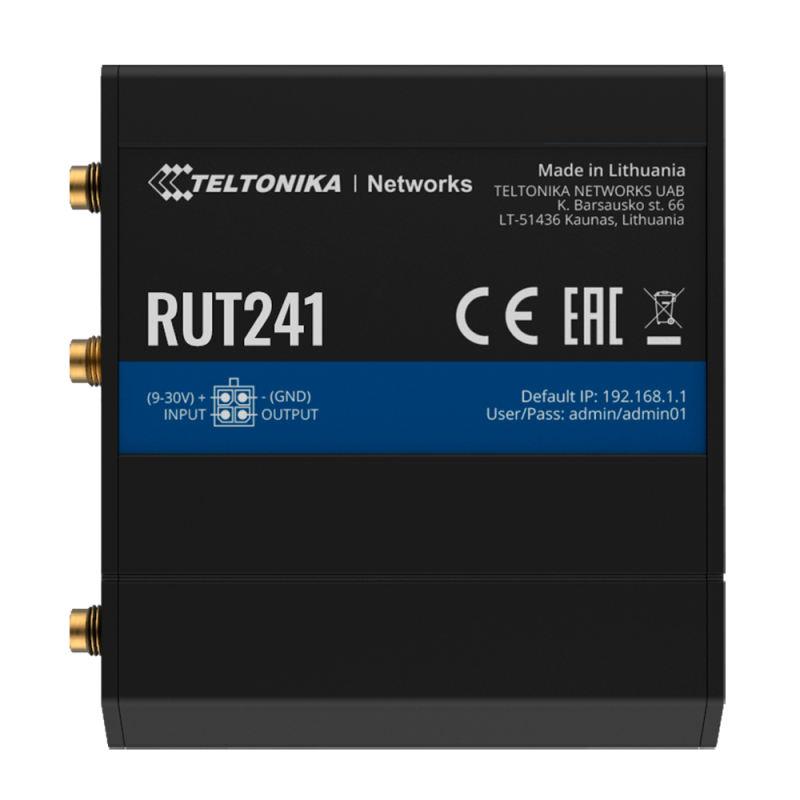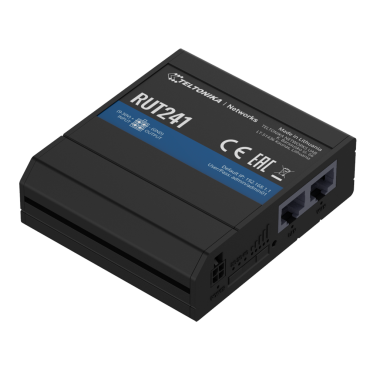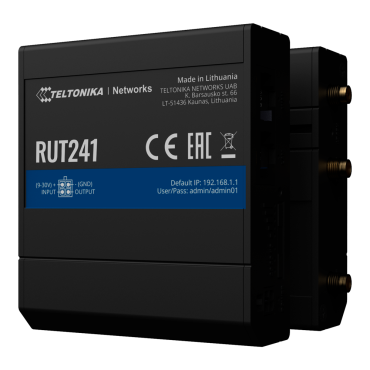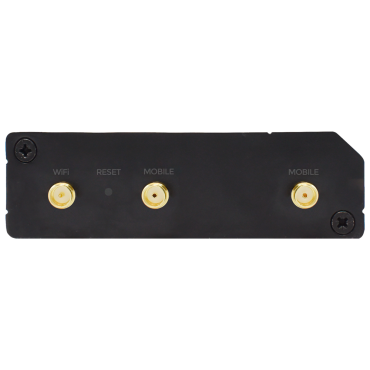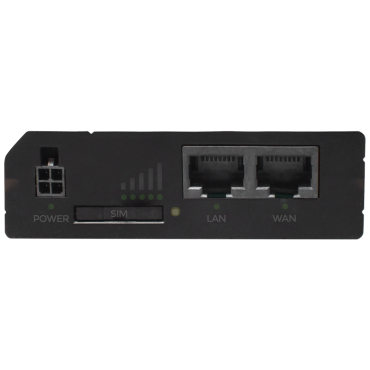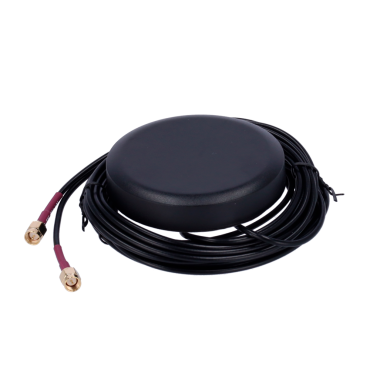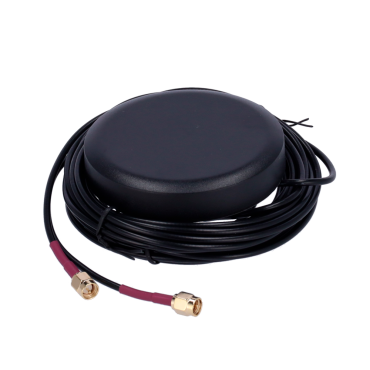- Brand: Teltonika
- Product Code: TK-RUT241
- Availability: In Stock
Om te bestellen en prijzen te kunnen zien moet u zich registreren of inloggen.
To order and view prices you must register or login.
To order and view prices you must register or login.
Teltonika Router 4G Industrial - 2 Ethernet ports RJ45 Fast Ethernet - 4G (LTE) Cat 4 to 150Mbps - 1x Digital Input/Output - Wi-Fi 802.11b/g/n 2.4GHz - Aluminum Housing
- Teltonika
- Industrial 4G Router
- 4G Cat4 / 3G / 2G
- 1 SIM Slot
- 2 Ethernet ports RJ45 Fast Ethernet
- Wi-Fi 802.11b/g/n 2.4GHz
- 1 Digital Input/Output
- 2x SMA for LTE antennas and 1x RP-SMA for Wi-Fi antenna
- 128MB RAM and 580MHz CPU
- Industrial 4 pin DC power connector
- DC power 9 to 30V Power Supply Included
- Status LEDs
| Article | |
| Brand | Teltonika |
| Product Code | TK-RUT241 |
| Manufacturer No. | RUT241 |
| Device | Industrial 4G Router |
| DNP3 | |
| Supported modes | TCP Master, DNP3 Outstation |
| EMI IMMUNITY | |
| CS | EN 61000-4-6:2009 |
| DIP | EN IEC 61000-4-11:2020 |
| EFT | EN 61000-4-4:2012 |
| ESD | EN 61000-4-2:2009 |
| IMMUNITY Standards | EN 301 489-1 V2.2.3 EN 301 489-17 V3.2.4 Final draft EN 301 489-52 V1.2.0 EN 55032:2015+A1:2020 EN 55035:2017+A11:2020 EN 61000-3-3:2013+A1:2019 EN IEC 61000-3-2:2019 |
| RS | EN 61000-4-2:2009 |
| Surge immunity (AC Power Line) | EN 61000-4-5:2014+A1:2017 |
| ETHERNET | |
| LAN | 1 x LAN port, 10/100 Mbps, compliance with IEEE 802.3, IEEE 802.3u standards, supports auto MDI/MDIX |
| Wan | 1 x WAN port 10/100 Mbps, compliance IEEE 802.3, IEEE 802.3u standards, supports auto MDI/MDIX |
| FIRMWARE / CONFIGURATION | |
| FOTA | Update FW |
| Keep settings | Update FW without losing current configuration |
| RMS | Update FW/configuration for multiple devices at once |
| WEB UI | Update FW from file, check FW on server, configuration profiles, configuration backup, restore point |
| FIRMWARE CUSTOMIZATION | |
| Development tools | SDK package with build environment provided |
| Operating system | RutOS (OpenWrt based Linux OS) |
| Supported languages | Busybox shell, Lua, C, C++ |
| INPUT / OUTPUT | |
| Events | Email, RMS, SMS |
| I/O juggler | Allows to set certain I/O conditions to initiate event |
| Input | 1 x Digital Input, 0 - 6 V detected as logic low, 8 - 30 V detected as logic high |
| Output | 1 x Digital Output, Open collector output, max output 30 V, 300 mA |
| IOT PLATFORMS | |
| Azure IoT Hub | Can send device IP, Number of bytes send/received, Temperature, PIN count to Azure IoT Hub server, Mobile connection state, Network link state, IMEI, ICCID, Model, Manufacturer, Serial, Revision, IMSI, SIM State, PIN state, GSM signal, WCDMA RSCP, WCDMA EC/IO, LTE RSRP, LTE SINR, LTE RSRQ, CELL ID, Operator, Operator number, Connection type |
| Cloud of Things | Allows monitoring of: Device data, Mobile data, Network info, Availability |
| Cumulocity | Allows monitoring of: Device Model, Revision and Serial Number, WAN Type and IP, Mobile Cell ID, ICCID, IMEI, Connection Type, Operator, Signal Strength |
| ThingWorx | Allows monitoring of: WAN Type, WAN IP, Mobile Operator Name, Mobile Signal Strength, Mobile Network Type |
| MOBiLE | |
| APN | Auto APN |
| Band management | Band lock, Used band status display |
| Black/White list | Operator black/white list |
| Bridge | Direct connection (bridge) between mobile ISP and device on LAN |
| Mobile module | 4G (LTE) – Cat 4 up to 150 Mbps, 3G – Up to 42 Mbps, 2G – Up to 236.8 kbps |
| Multiple PDN | Possibility to use different PDNs for multiple network access and services |
| Passthrough | Router assigns its mobile WAN IP address to another device on LAN |
| SMS | SMS status, SMS configuration, send/read SMS via HTTP POST/GET, EMAIL to SMS, SMS to EMAIL, SMS to HTTP, SMS to SMS, scheduled SMS, SMS autoreply, SMPP |
| Status | Signal strength (RSSI), SINR, RSRP, RSRQ, EC/IO, RSCP, Bytes sent/received, connected band, IMSI, ICCID |
| USSD | Supports sending and reading Unstructured Supplementary Service Data messages |
| MODBUS DATA TO SERVER | |
| Protocol | HTTP(S), MQTT, Azure MQTT |
| MODBUS TCP MASTER | |
| Supported data formats | 8 bit: INT, UINT; 16 bit: INT, UINT (MSB or LSB first); 32 bit: float, INT, UINT (ABCD (big-endian), DCBA (little-endian), CDAB, BADC) |
| Supported functions | 01, 02, 03, 04, 05, 06, 15, 16 |
| MODBUS TCP SLAVE | |
| Allow Remote Access | Allow access through WAN |
| Custom registers | MODBUS TCP custom register block requests, which read/write to a file inside the router, and can be used to extend MODBUS TCP Slave functionality |
| ID range | Respond to one ID in range [1;255] or any |
| MONITORING & MANAGEMENT | |
| Call | Reboot, Status, Mobile data on/off, Output on/off, answer/hang-up with a timer, WiFi on/off |
| FOTA | Firmware update from server, automatic notification |
| JSON-RPC | Management API over HTTP/HTTPS |
| MODBUS | MODBUS TCP status/control |
| MQTT | MQTT Broker, MQTT publisher |
| RMS | teltonika Remote Management System (RMS) |
| SMS | SMS status, SMS configuration, send/read SMS via HTTP POST/GET |
| SNMP | SNMP (v1, v2, v3), SNMP Trap |
| SSH | SSH (v1, v2) |
| TR-069 | OpenACS, EasyCwmp, ACSLite, tGem, LibreACS, GenieACS, FreeACS, LibCWMP, Friendly tech, AVSystem |
| WEB UI | HTTP/HTTPS, status, configuration, FW update, CLI, troubleshoot, event log, system log, kernel log |
| MQTT Gateway | |
| MQTT Gateway | Allows sending commands and receiving data from MODBUS Master through MQTT broker |
| OPERATING ENVIROMENT | |
| Ingress Protection Rating | IP30 |
| Operating humidity | 10% to 90% non-condensing |
| Operating temperature | -40 °C to 75 °C |
| PHYSICAL INTERFACES (PORTS, LEDS, BUTTONS, SIM) | |
| Antennas | 2 x SMA for LTE, 1 x RP-SMA for WiFi antenna connectors |
| Ethernet | 2 x RJ45 ports, 10/100 Mbps |
| I/O’s | 1 x Digital Input, 1 x Digital Output on 4-pin power connector |
| Power | 1 x 4 pin power connector |
| Reset | Reboot/User default reset/Factory reset button |
| SIM | 1 x SIM slot (Mini SIM – 2FF), 1.8 V/3 V, external SIM holder |
| Status LEDs | 3 x Connection type status LEDs, 5 x Connection strength LEDs, 2 x LAN status LEDs, 1 x Power LED |
| PHYSICAL SPECIFICATION | |
| Casing material | Aluminium housing, plastic panels |
| Dimensions (W x H x D) | 83 x 25 x 74 mm |
| Mounting options | Bottom and sideways DIN rail mounting slots |
| Weight | 125 g |
| POWER | |
| Connector | 4-pin industrial DC power socket |
| Input voltage range | 9 – 30 VDC, reverse polarity protection; surge protection >31 VDC 10us max |
| PoE (passive) | Passive PoE over spare pairs. Possibility to power up through LAN port, not compatible with IEEE802.3af, 802.3at and 802.3bt standards |
| Power Consumption | < 6.5 W Max |
| REGULATORY & TYPE APPROVALS | |
| Regulatory | CE/RED, UKCA, CB |
| RF | |
| Standards | EN 300 328 V2.2.2, EN 301 511 V12.5.1, EN 301 908-1 V13.1.1, EN 301 908-2 V13.1.1, EN 301 908-13 V13.1.1 |
| SAFETY | |
| Standards | EN IEC 62311:2020, EN 50665:2017, EN IEC 62368-1:2020+A11:2020, IEC 62368-1:2018 |
| SECURITY | |
| Access control | Flexible access control of TCP, UDP, ICMP packets, MAC address filter |
| Attack prevention | DDOS prevention (SYN flood protection, SSH attack prevention, HTTP/HTTPS attack prevention), port scan prevention (SYN-FIN, SYN-RST, X-mas, NULL flags, FIN scan attacks) |
| Authentication | Pre-shared key, digital certificates, X.509 certificates |
| Firewall | Pre-configured firewall rules can be enabled via WebUI, unlimited firewall configuration via CLI; DMZ; NAT; NAT-T |
| Mobile quota control | Custom data limits for SIM card |
| VLAN | Port and tag based VLAN separation |
| WEB filter | Blacklist for blocking out unwanted websites, Whitelist for specifying allowed sites only |
| SYSTEM CHARACTERISTICS | |
| CPU | Mediatek MIPS 24Kc 580 MHz |
| FLASH storage | 16 MB, SPI Flash |
| RAM | 128 MB, DDR2 |
| VPN | |
| DMVPN | Method of building scalable IPsec VPNs |
| GRE | GRE tunnel |
| IPsec | IKEv1, IKEv2, with 5 encryption methods for IPsec (DES, 3DES, AES128, AES192, AES256) |
| OpenVPN | Multiple clients and a server can run simultaneously, 12 encryption methods |
| OpenVPN Encryption | DES-CBC, RC2-CBC, DES-EDE-CBC, DES-EDE3-CBC, DESX-CBC, BF-CBC, RC2-40-CBC, CAST5-CBC, RC2-64-CBC, AES-128-CBC, AES-192-CBC, AES-256-CBC |
| PPTP, L2TP | Client/Server instances can run simultaneously, L2TPv3 support |
| SSTP | SSTP client instance support |
| Stunnel | Proxy designed to add TLS encryption functionality to existing clients and servers without any changes in the program’s code |
| WireGuard | WireGuard VPN client and server support |
| ZeroTier | ZeroTier VPN client support |
| WIRELESS | |
| SSID/ESSID | SSID stealth mode and access control based on MAC address |
| WiFi security | WPA2-Enterprise - PEAP, WPA2-PSK, WEP, WPA-EAP, WPA-PSK; AES-CCMP, TKIP, Auto Cipher modes, client separation |
| WiFi users | Up to 50 simultaneous connections |
| Wireless Hotspot | Captive portal (Hotspot), internal/external Radius server, built in customizable landing page |
| Wireless mode | EEE 802.11b/g/n, Access Point (AP), Station (STA) |
| Network | |
| Connection monitoring | Ping Reboot, Wget Reboot, Periodic Reboot, LCP and ICMP for link inspection |
| DDNS | Supported >25 service providers, others can be configured manually |
| DHCP | Static and dynamic IP allocation, DHCP Relay, Relayd |
| Firewall | Port forward, traffic rules, custom rules |
| Hotspot | Internal/external Radius server, captive portal, built in customizable landing page |
| Load balancing | Balance Internet traffic over multiple WAN connections |
| Network backup | WiFi WAN, Mobile, VRRP, Wired options, each of which can be used as an automatic Failover |
| Network protocols | TCP, UDP, IPv4, IPv6, ICMP, NTP, DNS, HTTP, HTTPS, FTP, SMTP, SSL v3, TLS, ARP, VRRP, PPP, PPPoE, UPNP, SSH, DHCP, Telnet, SMPP, SMNP, MQTT, Wake On Lan (WOL) |
| QoS / Smart Queue Management (SQM) | Traffic priority queuing by source/destination, service, protocol or port, WMM, 802.11e |
| Routing | Static routing |
| SSHFS | Possibility to mount remote file system via SSH protocol |
| VoIP passthrough support | H.323 and SIP-alg protocol NAT helpers, allowing proper routing of VoIP packets |

